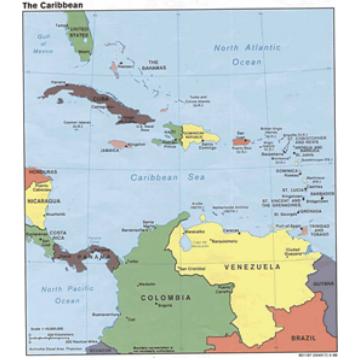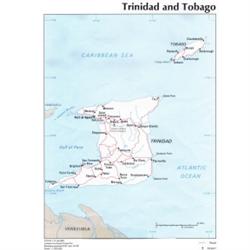
The Open School of Tropical Animal
Science and Production
1/12/2026 3:05:27 AM




THE CARIBBEAN AS A CONSERVATION HOTSPOT
Conservation International has identified the Caribbean as Biodiversity Hotspot. What is most interesting however is that Trinidad and Tobago are the only islands not included in their hotspot survey [Conservational International 2004]. They suggest that 11.3% of the Caribbean [including southern Florida and excluding Trinidad and Tobago] remain in its natural state. Trinidad and Tobago, however has about 33% of its landmass under natural vegetation [Table 3}. Thus suggests that this country has been historically a leader in conservation in the Caribbean.

Map of the Caribbean
Table 3: The amount of current forest cover recorded for Trinidad and Tobago.
| Trinidad (ha) | Tobago (ha) | Total (ha) | Percentage | |
| Forest Reserves | 99,435 | 3,958 | 103,393 | 20.0 |
| Forests on State Lands | 62,089 | 3,366 | 65,455 | 12.7 |
| Total | 161,524 | 7,324 | 168,845 | 32.0 |
Source: Wildlife Section, Forestry Division of the Ministry of the Environment.
Table 4 suggests that in the Caribbean there are several terrestrial species in need of attention. The only way that this could be successfully and sustainably done is with the use of captive breeding and ex situ conservation in Zoos. In this regard zoos whose primarily roles are Recreation, Education, Conservation and Research can be used to function as both plant and animal collections for display/ recreation and educational purposes.
Table 4: Vital Signs of Caribbean Biodiversity Hotspots [Excluding Trinidad and Tobago]
| Vital signs | Numbers |
| Hotspot Original Extent | 263,500 |
| Hotspot Vegetation Remaining | 29,840 |
| Area Protected | 41,000 |
| Plant Species | 12,000 |
| Endemic Plant | 7,000 |
| Terrestrial Vertebrate | 1,518 |
| Endemic Terrestrial Vertebrate | 779 |
| Threatened Species^ | 99 |
| Critically Endangered | 32 |
| Extinct Species^ | 51 |
^Endemic terrestrial vertebrates. Extinct species since 1500
Source: Conservation International 2004: http://www.biodiversityhotspots.org
Animal Biodiversity of Trinidad and Tobago
Trinidad and Tobago is centrally located within the neo-tropics. Trinidad and Tobago is a relatively small country, but its fauna is dense, and it contains the following:
Table 5: Species Diversity of Trinidad and Tobago
| Major groups | Number of species |
| Vascular plants | 2,160 |
| Mammals | 95 |
| Birds | 450 |
| Reptiles | 85 |
| Snakes | 41-47 |
| Insects | 5000 (estimated) |
| Butterflies | 600+ |
| Fresh water fishes | 45 |
| Marine fishes | 345 |
| Reef building corals | 6 |
| Nematodes | 200-300 |
| Amphibians | 30 |
Principle Source; Kenny, Comeau and Katwaru (1997) as cited by Cross (2001)

Map of Trinidad and Tobago
Trinidad and Tobago therefore has 630 terrestrial vertebrate species compared to the 1518 reported for the Caribbean in Table 4. Trinidad and Tobago is therefore animal biodiversity rich.